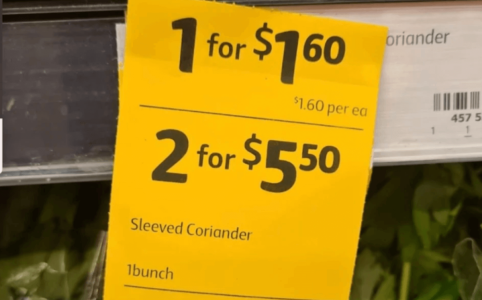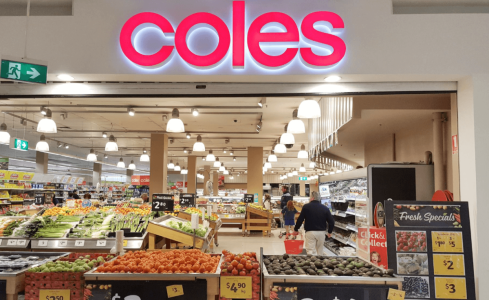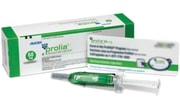Baffling pricing mix-up in Coles fresh produce aisle caught by shopper: ‘Always take a second look’
- Replies 3
For those of us who are always on the lookout for a good deal, yellow tags at Coles are like a beacon of hope. Whether it's milk, bread, or fresh produce, we know that we can often find discounts that make our wallets happy.
But not every yellow tag is a true bargain. As one savvy shopper from NSW learned this week, it's always important to double-check the prices before making a purchase.
The shopper found a pricing mistake in the coriander section that made two bunches of the fresh herb cost $5.50 - a strange increase of $1.15 if you bought two, compared to the individual cost ($1.60).
The shopper shared an image of the mistake on the Coles Facebook page and had this to say: 'I was lucky that I only needed one bunch of coriander. But I know that many people assume that anything with a yellow tag, especially “two for $x.xx”, is automatically a good deal.'
'This just shows that it's not always the case and it's always a good idea to take a second look.'

Upon discovering the pricing 'mistake', the customer wasted no time in checking with a staff member who, to their surprise, confirmed the higher price. But what could have been a frustrating experience turned out to be an eye-opening one.
As it turns out, the discounted price of $1.60 for a single bunch of coriander was not a mistake at all, but rather a strategic markdown to clear out an overstocked item. The regular price for a bunch of coriander is actually a whopping $3.20!
In contrast, the nearby parsley and mint were priced at $3.20 each or two for $5.50, which translates to a saving of 90 cents. It's clear that not all yellow tags are created equal, and taking the time to inspect the prices can save you some serious cash.
After this baffling pricing mistake was brought to their attention, Coles quickly addressed the issue. According to a spokesperson who spoke to a news source, this was an isolated incident and was specific to the store in question.
But what about the customer who spotted the mistake? Well, it turns out that the herb would have actually scanned at the lower price at the checkout, even if the customer had purchased two bunches.
In other words, the customer would have been charged a total of $3.20 for two bunches of coriander at the checkout, which is a far cry from the $5.50 price tag that was mistakenly displayed.

It's reassuring to know that Coles takes these kinds of issues seriously and rectifies them promptly.
As for the customer, they can rest easy knowing that they not only saved themselves some money but also helped to highlight the importance of paying attention to prices and not blindly assuming that all yellow tags represent a good deal.

It seems that pricing mistakes at Coles are not as rare as one might hope. In fact, this recent incident is not the first time that a customer has spotted a pricing 'mistake' in the supermarket.
In a previous article, we highlighted an incident where a customer discovered that the 'special' price of an item was actually the same as its regular price, despite being marked with the familiar yellow tag.
In other words, there were no savings or discounts to be had, regardless of whether the product was considered to be 'special'. Misleading? Some thought so.
Following the pricing blunder, Coles came forward with a statement addressing the issue. According to a spokesperson for the supermarket, the pricing error was simply the result of a few staff members making 'mistakes'.
Coles has a policy in place called 'Our Promise on Price Scanning', which is designed to ensure pricing accuracy at the registers and give customers confidence in their purchases.
In the event that a single item scans at a higher price than the advertised or ticketed shelf price, Coles will not only refund the difference but also give the customer that item for free.

It's refreshing to see a company go above and beyond what is required by law to make sure customers are treated fairly. Coles' commitment to pricing accuracy and customer satisfaction is a welcome relief for shoppers who are tired of feeling like they're being taken advantage of.
It's a good reminder that, despite occasional mistakes, Coles takes its responsibility to its customers seriously and is willing to do what it takes to make things right.
But these repeated incidents also make us beg the question: how many more pricing mistakes are lurking behind those tempting yellow tags?
It's a reminder that we must always be vigilant when it comes to inspecting prices and not assume that all yellow tags represent a good deal. After all, a little bit of extra effort can go a long way in saving us some serious money.
Members, this incident is a good reminder not to take pricing and discounts at face value. Next time you're browsing the yellow tags, give everything a double-check before selecting. And if it's not quite how it sounds, feel free to report it, so you can help all your fellow shoppers stay safe.
We hope you enjoyed this eye-opening story and found it as informative as we did - but now, let's hear from you! Do you have any experiences with those tempting yellow 'special' tags you'd like to share? Did you ever think you were getting a great deal, only to find out later that it was just a regular price? Or, maybe you've uncovered a fantastic bargain that you'd like to share with the rest of us?
We want to hear from you, so don't be shy - leave your thoughts and experiences in the comments below! Let's start a conversation about the ins and outs of supermarket pricing and see what we can all learn from each other.
But not every yellow tag is a true bargain. As one savvy shopper from NSW learned this week, it's always important to double-check the prices before making a purchase.
The shopper found a pricing mistake in the coriander section that made two bunches of the fresh herb cost $5.50 - a strange increase of $1.15 if you bought two, compared to the individual cost ($1.60).
The shopper shared an image of the mistake on the Coles Facebook page and had this to say: 'I was lucky that I only needed one bunch of coriander. But I know that many people assume that anything with a yellow tag, especially “two for $x.xx”, is automatically a good deal.'
'This just shows that it's not always the case and it's always a good idea to take a second look.'

A Coles customer spotted a special sticker on a bundle of coriander, labelling it as being one for $1.60 or two for $5.50. Credit: Facebook.
Upon discovering the pricing 'mistake', the customer wasted no time in checking with a staff member who, to their surprise, confirmed the higher price. But what could have been a frustrating experience turned out to be an eye-opening one.
As it turns out, the discounted price of $1.60 for a single bunch of coriander was not a mistake at all, but rather a strategic markdown to clear out an overstocked item. The regular price for a bunch of coriander is actually a whopping $3.20!
In contrast, the nearby parsley and mint were priced at $3.20 each or two for $5.50, which translates to a saving of 90 cents. It's clear that not all yellow tags are created equal, and taking the time to inspect the prices can save you some serious cash.
After this baffling pricing mistake was brought to their attention, Coles quickly addressed the issue. According to a spokesperson who spoke to a news source, this was an isolated incident and was specific to the store in question.
But what about the customer who spotted the mistake? Well, it turns out that the herb would have actually scanned at the lower price at the checkout, even if the customer had purchased two bunches.
In other words, the customer would have been charged a total of $3.20 for two bunches of coriander at the checkout, which is a far cry from the $5.50 price tag that was mistakenly displayed.
Key Takeaways
- A Coles customer in NSW questioned the supermarket's multi-buy pricing, showing it was more expensive to buy two bunches of coriander at the same store.
- The customer posted an image of the multi-buy price tag on Coles' Facebook page, causing confusion among shoppers.
- Coles confirmed the pricing tag was an error isolated to that store, saying the single bunch price was likely a store markdown.
As for the customer, they can rest easy knowing that they not only saved themselves some money but also helped to highlight the importance of paying attention to prices and not blindly assuming that all yellow tags represent a good deal.

After pulling the tag to reveal the original price of the spread, the shopper was surprised that it was also $6.50. Credit: TikTok.
It seems that pricing mistakes at Coles are not as rare as one might hope. In fact, this recent incident is not the first time that a customer has spotted a pricing 'mistake' in the supermarket.
In a previous article, we highlighted an incident where a customer discovered that the 'special' price of an item was actually the same as its regular price, despite being marked with the familiar yellow tag.
In other words, there were no savings or discounts to be had, regardless of whether the product was considered to be 'special'. Misleading? Some thought so.
Following the pricing blunder, Coles came forward with a statement addressing the issue. According to a spokesperson for the supermarket, the pricing error was simply the result of a few staff members making 'mistakes'.
Coles has a policy in place called 'Our Promise on Price Scanning', which is designed to ensure pricing accuracy at the registers and give customers confidence in their purchases.
In the event that a single item scans at a higher price than the advertised or ticketed shelf price, Coles will not only refund the difference but also give the customer that item for free.

A Coles representative explained that it was just a case of a staff member messing up the prices. Credit: Shutterstock.
It's refreshing to see a company go above and beyond what is required by law to make sure customers are treated fairly. Coles' commitment to pricing accuracy and customer satisfaction is a welcome relief for shoppers who are tired of feeling like they're being taken advantage of.
It's a good reminder that, despite occasional mistakes, Coles takes its responsibility to its customers seriously and is willing to do what it takes to make things right.
But these repeated incidents also make us beg the question: how many more pricing mistakes are lurking behind those tempting yellow tags?
It's a reminder that we must always be vigilant when it comes to inspecting prices and not assume that all yellow tags represent a good deal. After all, a little bit of extra effort can go a long way in saving us some serious money.
Members, this incident is a good reminder not to take pricing and discounts at face value. Next time you're browsing the yellow tags, give everything a double-check before selecting. And if it's not quite how it sounds, feel free to report it, so you can help all your fellow shoppers stay safe.
We hope you enjoyed this eye-opening story and found it as informative as we did - but now, let's hear from you! Do you have any experiences with those tempting yellow 'special' tags you'd like to share? Did you ever think you were getting a great deal, only to find out later that it was just a regular price? Or, maybe you've uncovered a fantastic bargain that you'd like to share with the rest of us?
We want to hear from you, so don't be shy - leave your thoughts and experiences in the comments below! Let's start a conversation about the ins and outs of supermarket pricing and see what we can all learn from each other.







